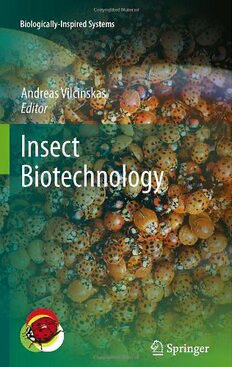
Insect Biotechnology PDF
Preview Insect Biotechnology
cover-large.gif (JPEG Imagen, 827x1311 pixels) - Escalado (43%) http://www.springerlink.com/content/w50574/cover-large.gif 1 de 1 30/10/2010 10:13 Biologically-Inspired Systems Volume 2 SeriesEditor StanislavN.Gorb Forfurthervolumes: http://www.springer.com/series/8430 Andreas Vilcinskas Editor Insect Biotechnology 123 Editor Prof.Dr.AndreasVilcinskas UniversityofGiessen InstituteofPhytopathologyandAppliedZoology Heinrich-Buff-Ring26-32 35392Giessen Germany [email protected] and FraunhoferInstituteofMolecularBiology andAppliedEcology DepartmentofBio-Resources WinchesterStrasse2 35394Giessen Germany ISBN978-90-481-9640-1 e-ISBN978-90-481-9641-8 DOI10.1007/978-90-481-9641-8 SpringerDordrechtHeidelbergLondonNewYork LibraryofCongressControlNumber:2010938005 ©SpringerScience+BusinessMediaB.V.2011 Nopartofthisworkmaybereproduced,storedinaretrievalsystem,ortransmittedinanyformorby anymeans,electronic,mechanical,photocopying,microfilming,recordingorotherwise,withoutwritten permissionfromthePublisher,withtheexceptionofanymaterialsuppliedspecificallyforthepurpose ofbeingenteredandexecutedonacomputersystem,forexclusiveusebythepurchaserofthework. Printedonacid-freepaper SpringerispartofSpringerScience+BusinessMedia(www.springer.com) Foreword The idea to publish this guide on latest applications, challenges and future trends in applied entomology arose in 2007 at the first International Congress on Insect BiotechnologyandIndustry(ICIBI)inDaegu(Korea),whichwasorganizedbythe KoreanEntomologicalSociety.Therapidandmulti-faceteddevelopmentsintheuse of insects or derivatives thereof in medical, agricultural, and industrial processes forhumanbenefitcallsforacomprehensiveguideprovidinginformationaboutthe principles behind each technology which share considerable economic potential. Insect biotechnology can be defined as the use of insects as well as insect-derived cells or molecules in medical (red biotechnology), agricultural (green biotechnol- ogy), industrial (white biotechnology), or other technological applications such as bionics which focuses on the systematic transfer of solutions from nature to the technical world. Biotechnology comprises a very broad spectrum of applications which are differentiated by established color codes, for example, “blue biotech- nology” refers to technological application of marine organisms to produce food, cosmetics,medication,ornewmaterials.Byanalogy,Iproposethealternativeterm “yellowbiotechnology”wheninsectsorinsect-derivedcellsormoleculesareused inmedical,pharmaceutical,agricultural,orindustrialapplicationsbecausethecolor code does not as yet include yellow and the insect hemolymph often has a yellow color. The remarkable advances in insect biotechnology are essentially driven by sci- entificbreakthroughsinmolecularbiology,particularlybythedevelopmentoftools and techniques that allow genetic characterization and engineering of organisms andcells.Theuseofinsectstoproducevaluablesorfoodisnotanewtechnology, but rather a tradition found in many human cultures. The long-term use of some insect species such as the silk moth or bees for human benefit finally resulted in their domestication similar to mammalian domestic animals such as cows, sheep, and camels. In fact, the production of silk by cocoon-spinning caterpillars of the silk moth Bombyx mori started in Asia more than 5,000 years ago and developed fromatraditionaltoanindustrialtechnologysincetheuseofsilkhasbeenexpanded beyondarawmaterialformanufacturingclothestoincludeitsapplicationinproduc- tionofhigh-techproductssuchasparachutesorbullet-proofwaistcoats.Beeshave beenexploitedasasourceofhoneyorwaxforcenturies.Becauseofthetraditional use of insects in Asian countries, which are still the biggest producers of silk and v vi Foreword honey, the emerging competition between them in developing insect biotechnol- ogyasahighlyprofitablefieldisnotsurprising.Forexample,competitionemerged betweenChinaandJapanastheyindependentlybegansequencingthegenomeofB. mori,butbothcampaignswerelatermergedresultinginsuccessfulcharacterization ofthefirstlepidopterangenome. However, based on our experiences insects may elicit negative associations because they are almost the most important competitors for human nutrition. The threatimposedbyinsectsonagriculturalproductionandstorageofhumanfoodhas plaguedhumanitythroughouthistory,beingmanifestedbylocustswarmsasoneof the seven biblical plagues. In addition, insects were and still are the most impor- tant vectors of human disease such as plague and malaria and, therefore, account indirectly for a hundred million deaths annually. Consequently, previous research inappliedentomologyhaspredominantlyfocusedondevelopmentofstrategiesand techniques to efficiently kill insects. Since it has been recognized that insectivore insectsorparasitoidsareimportantalliesinfightingagainstpestorvectorinsects, and that other beneficial insects such as bees play an economically important role aspollinators,ithasbecomeapparentthatsustainableandenvironmentallyfriendly approachesrequiretheavailabilityofselectiveinsectcontrolmeasures.Thetarget- ing of pests or vector insects has become imaginable as scientific breakthroughs in molecular biology such as RNA interference technology can be combined with expandingknowledgeaboutinsectgenomes.Duringthewritingofthechapterscon- tributing to this book in 2009, 50 insect genome projects had either been finished or were in progress. The outcome of all of these activities in the future may be crops expressing double-stranded RNA mediating silencing expression of essen- tial genes in pest insects without impeding non-target organisms. Additionally, other approaches such as insect transgenesis and sterile insect techniques have been proven to provide sophisticated alternative tools for targeted control of pest or vector insects. The rapidly spreading and growing knowledge about innovative approachesthatmeetthedefinitionofinsectbiotechnologyprovidedaboveclearly needs to be structured and comprehensively outlined in a textbook. Being aware thatonlyleadingexpertsintheirrespectivefieldsareabletoprovideinsightintothe state-of-the-artindifferentareasofinsectbiotechnologyandcorrespondingcutting- edgetechnologies,boththepublisherandtheeditorareconvincedthattheauthors selectedforeachchapterhaveproperlyaddressedhotspotsinthefield. The first part of the book focuses on the use of insects or insect-derived cells and molecules in human healthcare. Insects such as the caterpillars of the greater wax moth Galleria mellonella may effectively replace mammalian model hosts becausetheyarecheapertorearandethicallymoreacceptable,whileotherssuchas Drosophila are predestined for the study of molecular mechanisms behind human diseases like asthma. The application of insects in “red biotechnology” can be expandedbeyondtheiruseasmodelhostsandgeneticallytractablemodelorganisms to include their value as a source of novel compounds with therapeutic poten- tial. One impressive application of insects in medicine is highlighted in a chapter describing the development from traditional use of maggots in therapy of chronic and/or non-healing wounds to current approaches aiming at the identification of Foreword vii maggot-derivedmoleculeswiththerapeuticpotentialtogeneratesyntheticorrecom- binantanaloguesforapplicationinbiosurgery.Insectsrepresentthemostsuccessful groupoforganismsonearthregardingbiodiversity,andtheirtremendousvarietyat specieslevelmaybeextendedtothemolecularlevel.Takingintoaccountthatmany bioactive molecules identified in insects originate from associated microbes the diversityofinsect-derivedcompoundsisvirtuallyseveralordershigher.Therefore, two chapters have been incorporated which focus on molecules with therapeutic potentialproducedbyeithermicrobialsymbiontsorpathogensofinsects. Thesecondpartofthebookaddressestheinputofinsectbiotechnologytomod- ern and sustainable approaches in plant protection. “Green biotechnology” may profit from the raising spectrum of insect-derived genes encoding anti-microbial peptides whose transgenic expression has been proven to confer on crops resis- tanceagainsteconomicallyimportantphytopathogens.Identificationofspecies-or order-specific targets for RNA interference is the subject of a subsequent chap- terdescribinganotherpromisingtechnologyinplantprotectionwhichmayenable selectedmeasuresagainstpestinsectswhilenotimpedingnon-targetorganisms. Thethirdpartofthebookfocusesonindustrialapplicationofinsectsorinsect- derivedcellsormolecules.Insect-derivedcelllinesprosperinuseasheterologous expressionsystemsforproductionofpeptidesorproteinsused,forexample,asvac- cines in human healthcare or as enzymes mediating industrial processes in “white biotechnology.”Finally,insectbiotechnologyencompassesthedevelopmentofboth novelbiosensorsonthebasisofinsectolfactionandbiomimeticsinvariousareasof technology.Farfrombeingcomplete,the13clearlystructuredandsimplyexplained expertcontributionsmayprovideanoverviewaboutcurrentandprominentadvances in insect biotechnology which will help students and researchers to broaden their knowledge and to gain an understanding of both the challenges and the opportu- nitiesbehindeachapproach.Thisguidehasbeenwritteninordertostimulateand acceleratetheprocessofdevelopinginnovationsininsectbiotechnology.Finally,it maychangetheperceptionofinsectsbyentomologistsandnonexpertsinthefield inapositivemanner. Contents PartI InsectBiotechnologyinMedicine 1 TheGreaterWaxMothGalleriamellonellaasanAlternative ModelHostforHumanPathogens . . . . . . . . . . . . . . . . . . 3 KrishnenduMukherjee,EugenDomann,andTorstenHain 2 Fruit Flies as Models in Biomedical Research – A DrosophilaAsthmaModel . . . . . . . . . . . . . . . . . . . . . . . 15 ThomasRoeder,KerstinIsermann,ChristinaWagner, andChristineWarmbold 3 TherapeuticPotentialofAnti-MicrobialPeptidesfromInsects . . . 29 JochenWiesnerandAndreasVilcinskas 4 FromTraditionalMaggotTherapytoModernBiosurgery . . . . . 67 AndreasVilcinskas 5 Insect-AssociatedMicroorganismsasaSourceforNovel SecondaryMetaboliteswithTherapeuticPotential . . . . . . . . . 77 HelgeB.Bode 6 Potential Pharmaceuticals from Insects and Their Co-OccurringMicroorganisms . . . . . . . . . . . . . . . . . . . . 95 KonradDettner PartII InsectBiotechnologyinPlantProtection 7 InsectAntimicrobialPeptidesasNewWeaponsAgainst PlantPathogens . . . . . . . . . . . . . . . . . . . . . . . . . . . . . 123 CarinJansenandKarl-HeinzKogel 8 ProtectionofCropsAgainstInsectPestsUsingRNAInterference . 145 JohnA.GatehouseandDanielR.G.Price 9 InsectTransgenesisandtheSterileInsectTechnique . . . . . . . . 169 MarcF.ScheteligandErnstA.Wimmer ix
